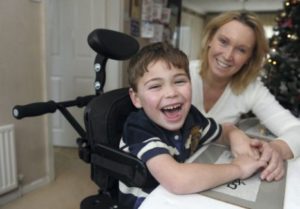Cerebral Palsy & The Gross Motor Function Classification System (GMFCS 1-5)
Children with cerebral palsy can suffer from different levels of motor impairment. There’s a classification system called the Gross Motor Function Classification System (or GMFCS) that’s used to classify the severity of motor function impairment in children aged 12 months to 12 years, with particular emphasis on sitting, walking, and overall mobility.

GMFCS and Cerebral Palsy
The Gross Motor Function Classification System is a reliable method of classifying young children with cerebral palsy into five specific groups, based on observation of the child’s self-initiated movements, their need for assistive technology, and their overall mobility.
Because the GMFCS focuses on the child’s physical abilities (rather than on severity, type, or distribution), knowing your child’s GMFCS level can prove valuable for parents, therapists, and pediatricians alike.
There are five levels to the GMFCS, with level one being the least severe and five being the most severe. Healthcare providers and physical therapists can better-assess the best type of treatment for an individual child when they have a general understanding of the child’s physical abilities. This knowledge is also a guideline for both parents and caregivers in helping them prepare for any expected future needs throughout the course of his or her development.
It’s important to understand that these five GMFCS levels are only guidelines, and your child may not exactly fit into just one category. Cerebral palsy does not affect each child in the exact same way, but here’s a general idea of how each level is broken down.
GMFCS LEVEL I
Ages 0-2 — Children up to the age of two will begin learning to sit on the floor, as well as play with and manipulate objects with their hands. They are also able to crawl, and are able to walk by the age of 18 months.
Ages 2-4 — The child can sit on the floor with no hand support, does not require assistance to move, and is able to walk without the need of assistive devices.
Ages 6-12 — The child can run, jump, walk, and climb stairs without using their hands for support, but speed, balance and/or coordination may be limited.
GMFCS LEVEL II
Ages 0-2 — At this level, children up to the age of two may begin to sit on the floor, provided they have assistance from an adult or use their hands as support. They also may begin to crawl either on their hands and knees or their bellies.
Ages 2-4 — The child can sit on the floor, but may not be able to balance without some hand support. They can crawl on their hands and knees, and pull themselves up to stand. They’re also able to walk using an assistive mobility device.
Ages 6-12 — The child can walk unassisted, and climb stairs using railing for support. The child may have difficulty with uneven surfaces, inclines/declines, or in crowds. Their ability to run or jump is usually minimal.
GMFCS LEVEL III
Ages 0-2 — While the child is able to roll and creep forward while positioned on his or her stomach, he or she will require lower back support in order to sit up.
Ages 2-4 — The child will often sit with their knees in front of them, and their feet out to their sides (commonly-referred to as “W-sitting”). They’re able to creep on their stomach or crawl (often awkwardly), may pull to stand on a stable surface, and may walk short distances using an assistive mobility device and/or adult assistance.
Ages 6-12 — The child can walk on even surfaces with the use of an assistive mobility device, and may be able to climb stairs using railing for support. The child may also be able to operate a manual wheelchair on even surfaces.
GMFCS LEVEL IV
Ages 0-2 — The child has head control, can roll between the back and stomach, but will likely require trunk assistance to sit up.
Ages 2-4 — Children are able to sit when placed in position, but are unable to maintain balance without use of their hands for support. Self-mobility is primarily limited to rolling, creeping on the stomach, or crawling on the hands and knees.
Ages 6-12 — The child primarily uses a wheelchair as their ability to walk is severely limited. The child may be able to operate a power wheelchair and participate in standing transfers.
GMFCS LEVEL V
Ages 0-2 — This is the most severe level. Children at this level have limited voluntary control of their movements and cannot support their head or trunk without support. They are also unable to roll over without assistance.
Ages 2-4 — The child may have a restricted voluntary control of movement, and is unable to support the head and trunk postures. Children have no means of independent mobility, though some children may be able to control a powered wheelchair with adaptations.
Ages 6-12 — The child cannot sit, stand, or walk independently, even with adaptive equipment. Child is usually impaired in all areas of motor function, and is unable to support the head and neck against gravity.
